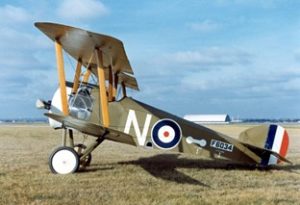
DAYTON, Ohio — Sopwith F-1 Camel at the National Museum of the United States Air Force. (U.S. Air Force photo)The Sopwith Camel was a British World War I single-seat biplane fighter put into service in 1917. Manufactured by Sopwith Aviation Company, it had what is called a “short coupled” fuselage (meaning that much of the weight which was the result of two machine guns, the engine, pilot, and fuel tank which represented 90% of the aircraft weight) was concentrated within seven feet of the aircraft nose. The location of the weight along with a strong gyroscopic effect from the engine made this airplane a challenge to fly!
Though difficult to handle, to an experienced pilot it provided unmatched maneuverability. It was a superlative fighter and was credited with shooting down 1,294 enemy aircraft, more than any other allied fighter of the War.
The Camel prototype was first flown in December 1916 and was powered by a 110 HP Clerget 9Z rotary engine. It was the first time an operational British-designed fighter had two machine guns that fired through the propeller disc. A metal fairing over the gun breeches, intended to protect the guns from freezing at altitude, created a “hump” that led to the name of Camel.
The Camel did not have a system for varying the incidence of the tailplane, thus the pilot had to apply constant forward pressure on the control stick to maintain a level attitude at low altitude. 5,490 Camels were built.
Some specifications:
Wingspan 28 feet Length 18 feet, nine inches Empty weight 930 pounds
Loaded weight 1,455 pounds Stall speed 48 MPH Maximum speed 115 MPH
Source: en.wikipedia.org/wiki/Sopwith_Camel
